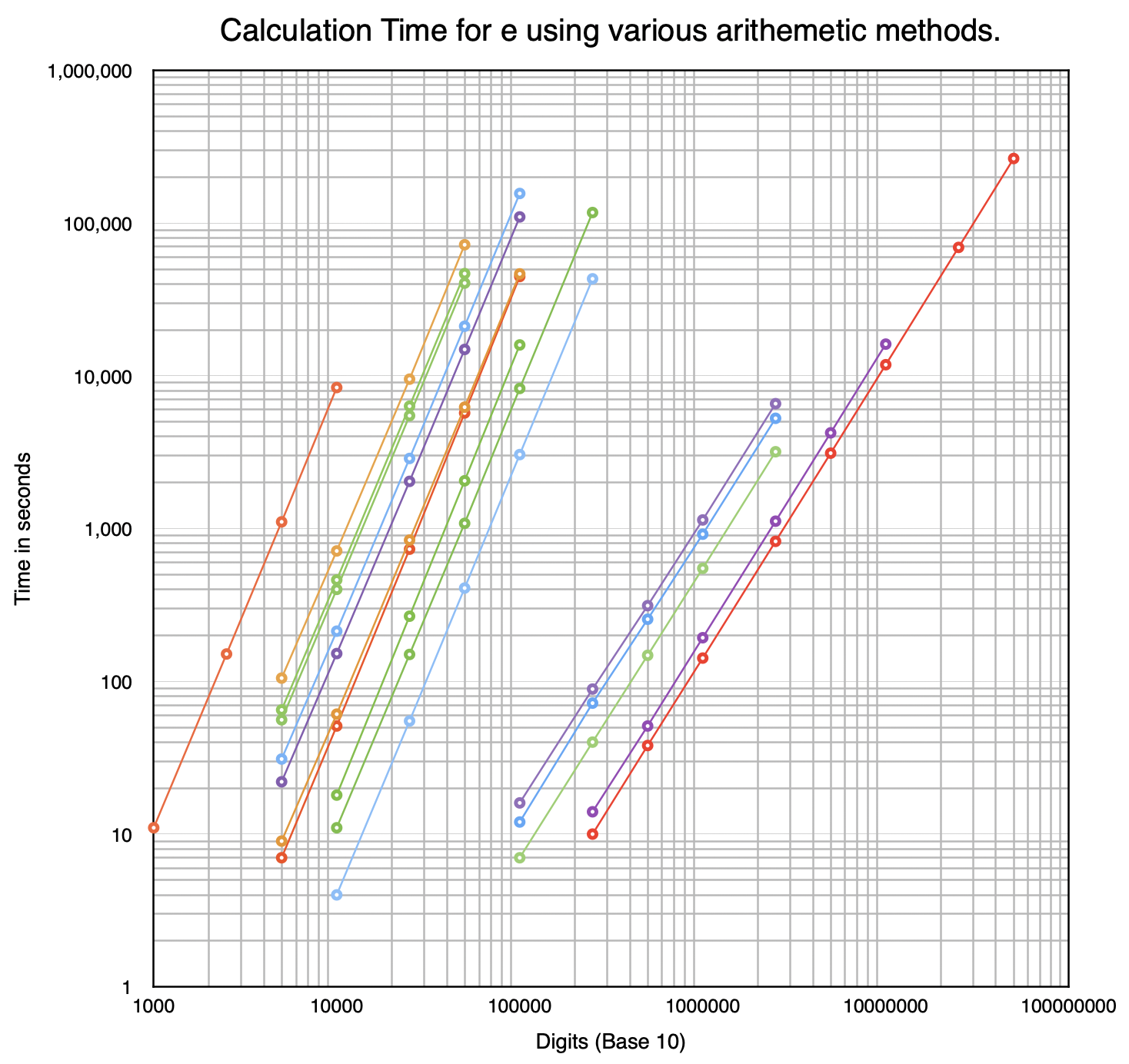This is a work in progress...
Calc-pi is a 64 bit assembly language program used to calculate π (pi). The interface is a simple text based RPN calculator intended to run in a Linux command line bash shell. It is fully stand alone and has no external library dependencies.
(Elapsed time: 0 Seconds 00:00:00) Op Code: sigfigs 1000 (Elapsed time: 0 Seconds 00:00:00) Op Code: c.pi (Elapsed time: 0 Seconds 00:00:00) Op Code: print f +3.1415926535 8979323846 2643383279 5028841971 6939937510 5820974944 5923078164 0628620899 8628034825 3421170679 8214808651 3282306647 0938446095 5058223172 5359408128 4811174502 8410270193 8521105559 6446229489 5493038196 4428810975 6659334461 2847564823 3786783165 2712019091 4564856692 3460348610 4543266482 1339360726 0249141273 7245870066 0631558817 4881520920 9628292540 9171536436 7892590360 0113305305 4882046652 1384146951 9415116094 3305727036 5759591953 0921861173 8193261179 3105118548 0744623799 6274956735 1885752724 8912279381 8301194912 9833673362 4406566430 8602139494 6395224737 1907021798 6094370277 0539217176 2931767523 8467481846 7669405132 0005681271 4526356082 7785771342 7577896091 7363717872 1468440901 2249534301 4654958537 1050792279 6892589235 4201995611 2129021960 8640344181 5981362977 4771309960 5187072113 4999999837 2978049951 0597317328 1609631859 5024459455 3469083026 4252230825 3344685035 2619311881 7101000313 7838752886 5875332083 8142061717 7669147303 5982534904 2875546873 1159562863 8823537875 9375195778 1857780532 1712268066 1300192787 6611195909 2164201989 (Elapsed time: 0 Seconds 00:00:00) Op Code:
64 bit Intel microprocessor or equivalent.
300 MB available memory for about 40M significant digits (adjustable).
64 bit Linux (Debian or Ubuntu amd64 recommended)
The GitHub repository contains assembly language source files. To build a binary executable, it is necessary to compile the program using the NASM assembler. The GitHub repository includes detail installation instructions in the README file.
GitHub Repository github.com/cotarr/calc-pi-x86-64-asm
Documentation: https://cotarr.github.io/calc-pi-x86-64-asm/
This application was intended for I/O limited to local keyboard and console output within a Linux command line shell. This calculation includes a rather ubiquitous use of memory pointers that have not been reviewed for safe pointer practices. Therefore, modification of the program to service a direct internet connection is not recommended.
System memory used for floating point number variables are defined in math.asm using RESQ statements to declare uninitialized blocks of memory in the BSS section. These are statically allocated when the program is started as part of the load image. No memory is dynamically allocated.
All input and output is performed using assembly language SYSCALL statements. All I/O functions are located in the "io_module.asm" file. They are used to accept keyboard input, produce console output, read and write numbers to disk files, capture program text output to a disk file, and read the system clock.
Filenames are specified by CLI input. The default path is the working directory. Filenames are not filtered to restrict path names, therefore, can write to any valid path with permission of the user running the program. I assume this is not an issue since you can do this independently from the CLI shell.
In simple terms, it is a set of assembly language floating point math calculations that can calculate several numeric constants like pi, e, ln(2) and square root of 2. In order to develop these internal functions, the math capabilities are wrapped into a very simple text based RPN calculator program. This calculator interface provides a very useful way to work with calculations as they are written and debugged.
This is not intended to be a multi-precision library. It is not intended to be a programming language. All of the internal programs are written in assembler, and there is no high level language programming capabilities. No validation or testing of the math functions has been performed.
Internal to the program, numbers are stored in binary floating point format using a 64 bit exponent and an arbitrary number of 64 bit words as the mantissa. Numbers are normalized by rotating bits until the most significant bit is non-zero. Negataive numbers are 2's complement.
The primary backbone calculation is a set of functions for binary floating point bitwise addition, subtraction, multiplication and long division. This is a simple straight forward way to do arithmetic with low risk of errors. Its easy to write and easy to debug. However, it is unfortunately very slow. It is literally operating on the numbers bit by bit. To speed up the calculation, several shortcuts have been added. These include: reducing the accuracy of multiplication and division when summing an infinite series, suspending normalization for intermediate calculations, replacing long division with multiplication of reciprocal, and using internal processor MUL command to multiply 64 bit registers to a 128 bit result, and DIV to divide 128 bit number by 64 bit to get a 64 bit quotient and remainder. The floating point functions are in the source files math-add.asm, math-mult.asm and math-div.asm
Some calculations, such as e and π do not require floating point format. The infinite series can be summed more efficiently when using a fixed point number. Time used to perform floating point normalization will be eliminated in this mode. In this case, the source file math-fixed.asm contains an alternate set of arithmetic functions that can add, subtract, multiply and divide variables in fixed point mode. In this format, the mantissa is shifted one word downward so the most significant 64 bit word represents the integer part of a fixed point number. The 64 bit integer word can easily hold the integer part of π or e. The rest of the mantissa words represent the fraction part which has arbitrary number of 64 bit words. Fixed point mode is only used during the intermediate summation of an infinite series. Variables are always converted to floating point format at the end of a calculation. Only floating point numbers can be printed. There are functions to convert between fixed point and floating point format.
Programming of these efficiency tricks was typically developed using the summation of Σ (1/n!) to calculate e. Experiments involving various software edits were put into a spreadsheet for comparison. The following chart shows a little history of efforts to improve the speed. However, after working with these improvements for a while, it seems programming "tricks" to improve speed can often cause unexpected errors or artifacts.
